

Multiplying large numbers is easy when breaking down the problem into parts!

Author
Amber Watkins
Published
November 14, 2023


Multiplying large numbers is easy when breaking down the problem into parts!

Author
Amber Watkins
Published
Nov 14, 2023


Multiplying large numbers is easy when breaking down the problem into parts!

Author
Amber Watkins
Published
Nov 14, 2023


Key takeaways
Table of contents
Are you encountering large numbers in maths? They can seem a bit scary at first! But luckily, there’s a silly saying that can help: ‘How to eat an elephant? One bite at a time!’. It teaches us that if you have a large task, the best way to do it is in parts.
The same can be true with multiplication. When we are given large numbers to multiply, instead of trying to do the problem all at once in our heads, we can multiply those numbers in parts.
When we multiply large numbers in parts, then add those parts together, it’s called long multiplication.
Long multiplication is the steps you follow to multiply larger numbers in an easy way. Long multiplication allows you to find partial answers and add them together to find the final product.
For example, instead of multiplying the numbers 64 x 32 as they are, you can break up the number 32 into two parts: 30 and 2, then multiply those parts by 64. It would look like this:
(64 x 2) + (64 x 30)
128 + 1,920
You would get a total of 2,048.
Multiplying in parts, and then adding the products together, makes multiplying large numbers easy!
Unlock unlimited maths questions
Put your learning into practice with fun exercises + games that are proven to boost ability!
When doing long multiplication problems in a column method, you first line up the numbers you’re multiplying in columns.

For example, would we set up the problem 64 x 32 using the column method?
Let’s keep this in mind when reviewing the steps for how to do long multiplication.
Try DoodleMaths for free!
Select a year group
Let’s learn the use what’s known as the column method to solve the following problem:
What is 33 x 21?
1. Line up the numbers in a column format.
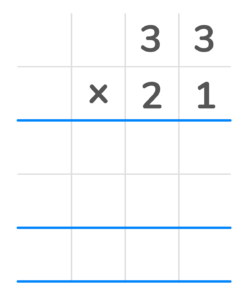
2. Multiply each top digit by the last digit in the bottom number. Place each answer in the first row from right to left. You should have the number 33 in the first product row.

3. Once each of the top digits is multiplied by that number, cross it off.
4. Next add a zero as a place value holder in the second row to represent already multiplying by the digit in that place value.

5. Multiply each top digit by the first digit in the bottom number. You will have the number 660 in the second partial product row.
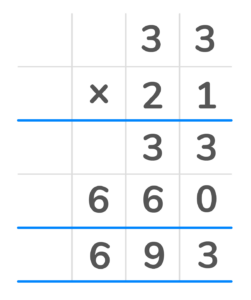
6. Finally add the two products 31 and 660 to get the final answer of 693.
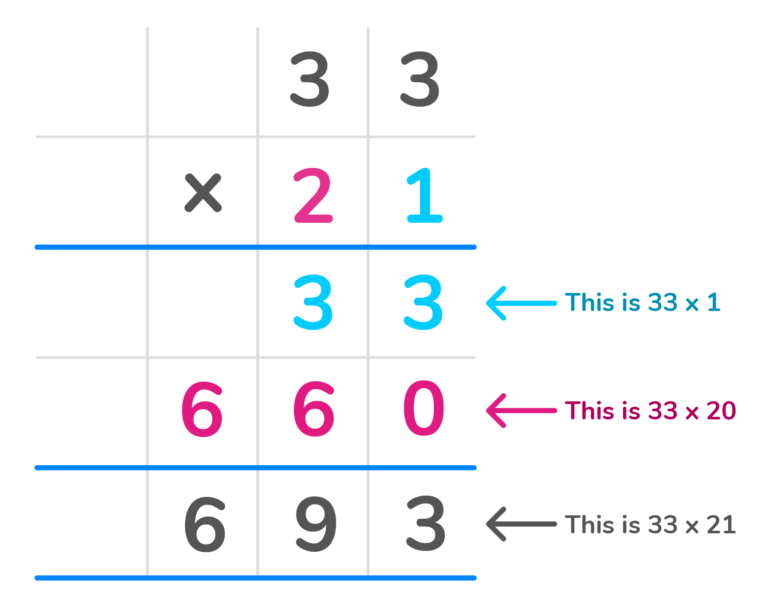
DoodleMaths is an award-winning app that’s filled with thousands of questions and games exploring multiplication, division and more!
Designed by teachers, it creates each child a unique work programme tailored to their needs, doubling their progression with just 10 minutes of use a day. Try it for free!


If you multiply two digits and the answer is in the double digits, the carry-over rule says you must write the second digit in the partial product line, and the first digit above the next number you will need to multiply. That way it carries over.
Let’s see how these long multiplication steps and the carry-over rule work
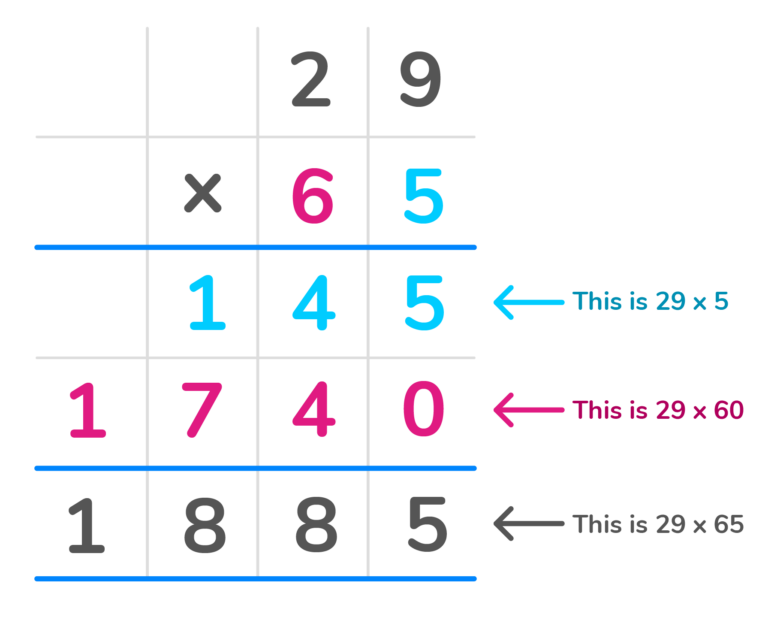
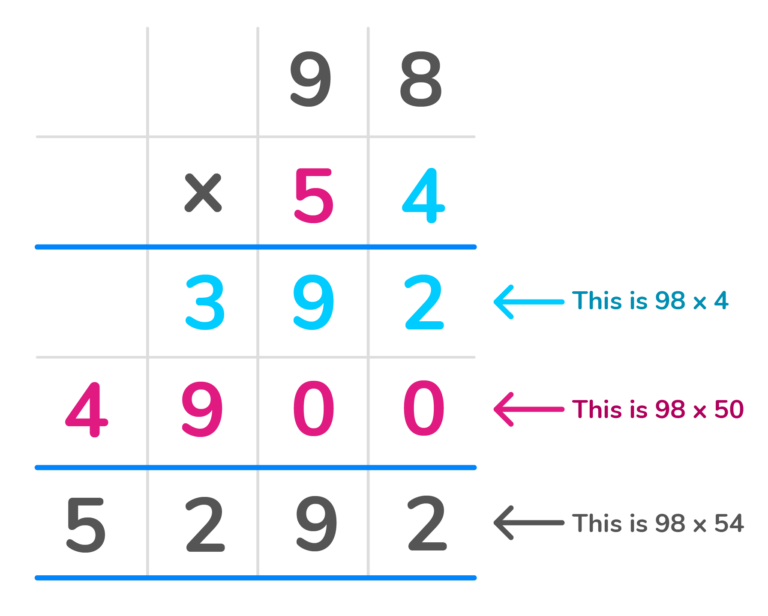
There’s also another way to do long multiplication – the horizontal method. The horizontal method allows us to break up the second number in parts and multiply those parts by the first number.
Let’s learn how to do long multiplication with the horizontal method. Let’s look at this example.
Multiply 43 x 65 using the horizontal method
1. Write the second number 65 in Expanded form. Those two numbers will be the parts we multiply the first number 43 by.
65 in Expanded form is 60 + 5.
2. Begin by multiplying 43 by the first part, 60. This can be done by multiplying 43 x 6, then adding a zero to the answer.
43 x 6 is 258.
Then add a zero, so it would be 2580.
3. Next we will multiply 43 by the second part 5.
43 x 5 is 215.
4. Finally, we add the two partial products together to get the final answer.
2580 + 215 is 2,795.
Click on the boxes below to see the answers!
You do long multiplication by multiplying numbers in parts. You multiply each digit in the top number, by each digit in the bottom number. Finally, you add the partial products to get the final answer.
Long multiplication helps make multiplication with large numbers easy. The more you practice long multiplication, the easier these problems will be.
The long multiplication method is often called the column method. This is because the numbers you multiply are written above and below one another in columns.
You begin learning long multiplication in Year 5 and learn to multiply even larger numbers in Year 6.

Lesson credits

Amber Watkins
Amber is an education specialist with a degree in Early Childhood Education. She has over 12 years of experience teaching and tutoring. "Knowing that my work in math education makes such an impact leaves me with an indescribable feeling of pride and joy!"

Amber Watkins
Amber is an education specialist with a degree in Early Childhood Education. She has over 12 years of experience teaching and tutoring . "Knowing that my work in math education makes such an impact leaves me with an indescribable feeling of pride and joy!"
How to multiply fractions
Take your learning further by exploring how to multiply fractions
Easy ways to learn times tables
Take a look at our tips for learning the 1-12 times tables off by heart
The best order to learn times tables
We outline the best (and easiest!) order to learn the 1-12 multiplications in
Book a chat with our team
If you’d like to use Doodle’s browser version, please visit this page on a desktop.
To log in to Doodle on this device, you can do so through our apps. You can find out how to download them here: